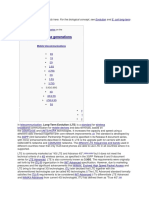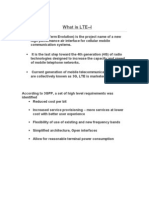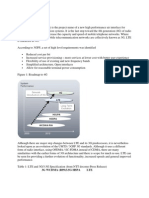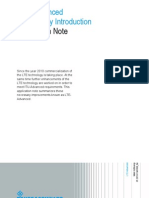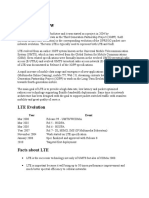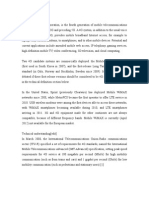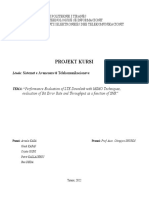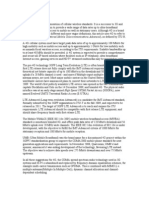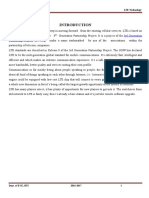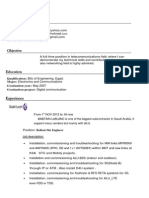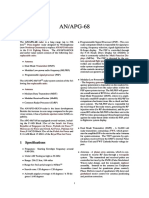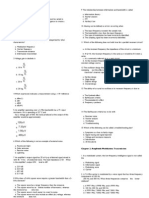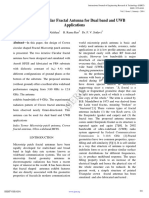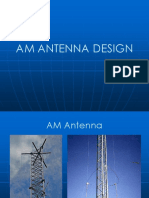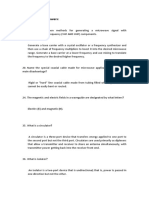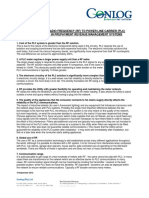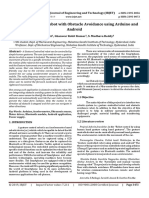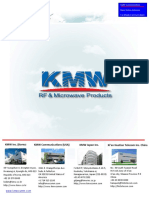Communication (II)
Mobile Report
Supervised by
Dr. Suzan Shokry
Jan 2012
Ahmed El Said Ibrahim 32007046
1 Introduction about LTE
3GPP Long Term Evolution, usually referred to as LTE, is a standard for
wireless communication of high-speed data for mobile phones and data terminals. It is
based on the GSM/EDGE and UMTS/HSPA network technologies, increasing the
capacity and speed using new modulation techniques. The standard is developed by
the 3GPP(3rd Generation Partnership Project). The world's first publicly available
LTE service was launched by TeliaSonera in the Scandinavian capitals
Stockholm and Oslo on 14 December 2009. LTE is the natural upgrade path for
carriers with GSM/UMTS networks, but even CDMA holdouts such as Verizon in
North America and au by KDDI in Japan have announced that they will migrate to
LTE in the future. LTE is therefore anticipated to become the first truly global mobile
phone standard. Although commonly referred to as a type of 4G wireless service, LTE
release 8 currently in use does not satisfy the requirements set forth by the ITU-
R organization. Future releases of LTE (referred to as LTE Advanced) are expected to
satisfy the requirements to be considered 4G.
LTE is a standard for wireless data communications technology and an
evolution of the GSM/UMTS standards. The goal of LTE is to increase the capacity
and speed of wireless data networks using new DSP (Digital Signal Processing)
techniques and modulations that were developed in the beginning of the new
millennium. Its wireless interface is incompatible with 2G and 3Gnetworks, and so it
must be operated on a separate wireless spectrum. LTE was first proposed by NTT
DoCoMo of Japan in 2004. The standard was finalized in December 2008, and the
first publicly available LTE service was launched by TeliaSonera in the Scandinavian
capitals Stockholm and Oslo on December 14, 2009 as a data connection with a USB
modem. In 2011, LTE services were launched by major North American carriers as
well, with the Samsung Galaxy Indulge offered by MetroPCS starting on February 10,
2011 being the first commercially available LTE phone and HTC
ThunderBolt offered by Verizon starting on March 17 being the second LTE phone to
be sold commercially. Initially, CDMA operators planned to upgrade to a rival
standard called the UMB, but all the major CDMA operators (such
as Verizon, Sprint and MetroPCS in the United States, Bell and Telus in Canada, au
by KDDI in Japan, SK Telecom in South Korea and China Telecom/China Unicom in
China) have announced that they intend to migrate to LTE after all. The evolution of
LTE is LTE Advanced, which was standardized in March 2011. Services are expected
to commence in 2013. The LTE specification provides down-link peak rates of
300 Mbit/s, uplink peak rates of 75 Mbit/s and QoS provisions permittinground-trip
times of less than 10 ms. LTE has the ability to manage fast-moving mobiles, and
support for multi-cast and broadcast streams. LTE supports scalable
carrier bandwidths, from 1.4 MHz to 20 MHz and supports both frequency division
duplexing (FDD) and time-division duplexing (TDD). The architecture of the network
is simplified to a flat IP-based network architecture called the Evolved Packet
Core (EPC), designed to replace the GPRS Core Network and support seamless
handovers for both voice and data to cell towers with older network technology such
as GSM, UMTS and CDMA2000. The simpler architecture results in lower operating
costs (for example, each E-UTRAN cell will support up to four times the data and
voice capacity when compared to HSPA.
Fig.1 Telia-branded Samsung LTE modem
Fig.2 HTC ThunderBolt, the second commercially available LTE mobile phone
Is LTE, the 4G technology? Though LTE is "marketed" as 4G, LTE in its
current form is not the REAL 4G technology. A simple reason being the 4G
technology requires 1Gbps data download speed and LTE cannot provide it today.
The pre-4G technology 3GPP Long Term Evolution (LTE) is often branded "4G", but
the first LTE release does not fully comply with the IMT-Advanced requirements.
LTE has a theoretical net bit rate capacity of up to 100 Mbit/s in the downlink and
50 Mbit/s in the uplink if a 20 MHz channel is used and more if multiple-input
multiple-output (MIMO), i.e. antenna arrays, are used. The physical radio interface
was at an early stage named High Speed OFDM Packet Access (HSOPA), now
named Evolved UMTS Terrestrial Radio Access (E-UTRA). The first LTE USB
dongles do not support any other radio interface.
The world's first publicly available LTE service was opened in the two
Scandinavian capitals Stockholm (Ericsson and Nokia Siemens Networks systems)
and Oslo (a Huawei system) on 14 December 2009, and branded 4G. The user
terminals were manufactured by Samsung. Currently, the three publicly available LTE
services in the United States are provided by MetroPCS, Verizon
Wireless, and AT&T. Sprint Nextel has also stated it's considering switching
from WiMax to LTE in the near future.
2- Requirements for Long Term Evolution
LTE is focusing on optimum support of Packet Switched (PS) Services.
Main requirements for the design of an LTE system were identified in the
beginning of the standardization work on LTE and have been captured in 3GPP
TR 25.913.They can be summarized as follows:
1. Data Rate: Peak data rates target 100 Mbps (downlink) and 50
Mbps (uplink) for 20 MHz spectrum allocation, assuming 2
receive antennas and 1 transmit antenna at the terminal. Note: These
requirement values are exceeded by the LTE specification.
2. Throughput: Target for downlink average user throughput per
MHz is 3-4 times better than release 6. Target for uplink average
user throughput per MHz is 2-3 times better than release 6.
3. Spectrum Efficiency: Downlink target is 3-4 times better than release
6. Uplink target is 2-3 times better than release 6.
4. Latency: The one-way transit time between a packets being available
at the IP layer in either the UE or radio access network and the
availability of this packet at IP layer in the radio access
network/UE shall be less than 5 ms. Also C-plane latency shall
be reduced, e.g. to allow fast transition times of less than 100 ms
from camped state to active state.
5. Bandwidth: Scaleable bandwidths of 5, 10, 15, 20 MHz shall be
supported. Also bandwidths smaller than 5 MHz shall be
supported for more flexibility, i.e. 1.4 MHz and 3 MHz.
6. Interworking: Interworking with existing UTRAN/GERAN systems
and non-3GPP systems shall be ensured. Multimode terminals shall
support handover to and from UTRAN and GERAN as well as
inter-RAT LTE/E-UTRA 1MA111_2E 5 Rohde & Schwarz
measurements. Interruption time for handover between E-UTRAN
and UTRAN/GERAN shall be less than 300 ms for real time
services and less than 500 ms for non real time services.
7. Costs: Reduced CAPEX and OPEX including backhaul shall be
achieved. Cost effective migration from release 6 UTRA radio
interface and architecture shall be possible. Reasonable system and
terminal complexity, cost and power consumption shall be
ensured. All the interfaces specified shall be open for multi-vendor
equipment interoperability.
8. Mobility: The system should be optimized for low mobile speed
(0-15 km/h), but higher mobile speeds shall be supported as well
including high speed train environment as special case.
9. Spectrum allocation: Operation in paired (Frequency Division Duplex /
FDD mode) and unpaired spectrum (Time Division Duplex / TDD
mode) is possible.
10. Co-existence: Co-existence (Compatible ) in the same geographical
area and collocation with 2G/3G (GSM/CDMA/HSPA)shall be
ensured. Also, co-existence between operators in adjacent bands as
well as cross-border coexistence is a requirement.
11. Quality of Service: End-to-end Quality of Service (QoS) shall be
supported. VoIP should be supported with at least as good radio
and backhaul efficiency and latency as voice traffic over the
UMTS circuit switched networks
3- Modulation & Multiple Accesses
Downlink: OFDM / OFDMA
Allows simple receivers in the terminal in case of large bandwidth
#subcarriers scales with bandwidth (76 ... 1201)
frequency selective scheduling in DL (i.e. OFDMA)
Adaptive modulation and coding (up to 64-QAM)
Uplink: SC-FDMA (Single Carrier - Frequency Division Multiple Access)
A FFT-based transmission scheme like OFDM
But with better PAPR (Peak-to-Average Power Ratio)
The total bandwidth is divided into a small number of frequency blocks to
be assigned to the UEs (e.g., 15 blocks for a 5 MHz bandwidth)
With Guard Interval (Cyclic Prefix) for easy Frequency Domain
Equalization (FDE) at receiver
Multiple Antenna Schemes
Minimum antennas requirement: 2 at eNodeB, 2 Rx at UE
Beamforming
Improves throughput at cell edge
Spatial Multiplexing _ MIMO
Needs good channel conditions
high SNR to enable good channel estimation
rich scattering environment, high spatial diversity, but NLOS !
Improves throughput in cell center
Multi-Antena Diversity
Fall back solution if channel conditions dont allow MIMO
MIMO Basics
Transmission of several independent data streams in parallel over
uncorrelated antennas (i.e. separated by 10 l)
increased data rate
The radio channel consists of N
Tx
x N
Rx
(ideally uncorrelated) paths
Theoretical maximum rate increase factor = Min (N
Tx
, N
Rx
) (in a rich
scattering environment; no gain in a line-of-sight environment)
Fig.3 MIMO Transmission
Fig.4 High Data rate when increasing no. of MIMO Antennas
MIMO Support is Different in Downlink and Uplink
Downlink MIMO
Supports Spatial Multiplexing, MU-MIMO, and Transmit Diversity
Uplink MIMO
Initial release of LTE will only support MU-MIMO with a single PA at
theUE
desire to avoid multiple PAs at UE
Cyclic-shift orthogonal pilots used in the uplink to facilitate MU-MIMO
operation.
4- LTE Architecture: Functional Description of Nodes
eNB ( Enhanced or Evolved Node Block)
contains all radio access
functions
Radio admission control
Scheduling of UL and DL data
Scheduling and transmission of
paging and system broadcast
IP header compression (PDCP)
Outer-ARQ (RLC)
MME (Mobility Management Entity)
Authentication
Tracking area list management
Idle mode UE reachability
S-GW/PDN-GW selection
Inter core network node signaling for mobility
between 2G/3G and LTE
Bearer management functions
Fig.5 LTE Architecture
Serving Gateway
Local mobility anchor for inter-eNB handovers
Mobility anchoring for inter-3GPP handovers
Idle mode DL packet buffering
Lawful interception
Packet routing and forwarding
PDN Gateway
IP anchor point for bearers
UE IP address allocation
Per-user based packet filtering
Connectivity to packet data network
PCRF (Policy & Charging Rules Function)
Network control of Service Data Flow (SDF) detection, gating, QoS &
flow based charging
Dynamic policy decision on service data flow treatment in the PCEF
(xGW)
Authorizes QoS resources
Fig.6 Logical high level architecture for the evolved system
Fig.7 Functional Split between E-UTRAN
5- Intra-LTE Handover
Network controlled handover:
decision taken by Source ENB
Preparation phase
preparation of Target eNodeB by context transfer prior to HO command
Break before make approach
core network not involved during preparation phase
Temporary forwarding of UP data from Source ENB to Target ENB
Path switching at AGW(sGW & PDN GW)
after establishment of new connection between UE and Target ENB
no temporary buffering at AGW
Performance
short interruption time in the range of 30 ms
same handover procedure applicable for real-time (delay sensitive) and
non real-time (non delay sensitive) services
suitable for lossless and seamless handovers
Fig.8 Intra-LTE Handover
6- Objectives
New core network architecture to support the high-throughput / low latency
LTE access system
Simplified network architecture
All IP network
All services are via PS domain only, No CS domain
Support mobility between multiple heterogeneous access system
2G/3G, LTE, non 3GPP access systems (e.g. WLAN, WiMAX)
Inter-3GPP handover (GPRS <> E-UTRAN): Using GTP-C based
interface for exchange of Radio info/context to prepare handover
Inter 3GPP non-3GPP mobility: Evaluation of host based (MIPv4, MIPv6,
DSMIPv6) and network based (NetLMM, PMIPv4, PMIPv6) protocols
7- Snapshot on LTE-Advanced
LTE Advanced is a preliminary mobile communication standard, formally
submitted as a candidate 4G system to ITU-T in late 2009, was approved into ITU,
International Telecommunications Union, IMT-Advanced and expected to be
finalized by 3GPP in early 2011. It is standardized by the 3rd Generation Partnership
Project (3GPP) as a major enhancement of the 3GPP Long Term Evolution (LTE)
standard. The LTE format was first proposed by NTT DoCoMo of Japan and has been
adopted as the international standards. LTE standardization has come to a mature state
by now where changes in the specification are limited to corrections and bug fixes.
The first commercial services were launched in Sweden and Norway in December
2009 followed by the United States and Japan in 2010. More first release LTE
networks are expected to be deployed globally during 2010 as a natural evolution of
several 2G and 3G systems, including Global system for mobile
communications (GSM) and Universal Mobile Telecommunications System (UMTS)
(3GPP as well as 3GPP2).
Being described as a 3.9G (beyond 3G but pre-4G) technology the first release
LTE does not meet the requirements for 4Galso called IMT Advanced as defined
by theInternational Telecommunication Unionsuch as peak data rates up to
1 Gbit/s. The ITU has invited the submission of candidate Radio Interface
Technologies (RITs) following their requirements as mentioned in a circular letter.
The work by 3GPP to define a 4G candidate radio interface technology started in
Release 9 with the study phase for LTE-Advanced. The requirements for LTE-
Advanced are defined in 3GPP Technical Report (TR) 36.913, "Requirements for
Further Advancements for E-UTRA (LTE-Advanced)." These requirements are based
on the ITU requirements for 4G and on 3GPP operators own requirements for
advancing LTE. Major technical considerations include the following:
Continual improvement to the LTE radio technology and architecture
Scenarios and performance requirements for interworking with legacy radio
access technologies
Backward compatibility of LTE-Advanced with LTE. An LTE terminal should
be able to work in an LTE-Advanced network and vice versa. Any exceptions
will be considered by 3GPP.
Account taken of recent World Radiocommunication Conference (WRC-07)
decisions regarding new IMT spectrum as well as existing frequency bands to
ensure that LTE-Advanced geographically accommodates available spectrum
for channel allocations above 20 MHz. Also, requirements must recognize
those parts of the world in which wideband channels are not available.
Likewise, 802.16m, 'WiMAX 2', has been approved by ITU into the IMT
Advanced family. WiMAX 2 is designed to be backward compatible with WiMAX
1/1.5 devices. Most vendors now support ease of conversion of earlier 'pre-4G', pre-
advanced versions and some support software defined upgrades of core base station
equipment from 3G.
The mobile communication industry and standardization organizations have
therefore started to work on 4G access technologies such as LTE Advanced. At a
workshop in April 2008 in China, 3GPP agreed the plans for future work on Long
Term Evolution (LTE). A first set of 3GPP requirements on LTE Advanced has been
approved in June 2008. Besides the peak data rate 1 Gbit/s that fully supports the 4G
requirements as defined by the ITU-R, it also targets faster switching between power
states and improved performance at the cell edge. Detailed proposals are being
studied within the working groups
The target of 3GPP LTE Advanced is to reach and surpass
the ITU requirements. LTE Advanced should be compatible with first release LTE
equipment, and should share frequency bands with first release LTE. In the feasibility
study for LTE Advanced, 3GPP determined that LTE Advanced would meet the ITU-
R requirements for 4G. The results of the study are published in 3GPP Technical
Report (TR) 36.912.
One of the important LTE Advanced benefits is the ability to take advantage
of advanced topology networks; optimized heterogeneous networks with a mix of
macrocells with low power nodes such as picocells, femtocells and new relay nodes.
The next significant performance leap in wireless networks will come from making
the most of topology, and brings the network closer to the user by adding many of
these low power nodes LTE Advanced further improves the capacity and coverage,
and ensures user fairness. LTE Advanced also introduces multicarrier to be able to use
ultra wide bandwidth, up to 100 MHz of spectrum supporting very high data rates.
In the research phase many proposals have been studied as candidates for LTE
Advance technologies. The proposals could roughly be categorized into:
Support for relay node base stations
Coordinated multipoint (CoMP) transmission and reception
UE Dual TX antenna solutions for SU-MIMO and diversity MIMO
Scalable system bandwidth exceeding 20 MHz, Up to 100 MHz
Carrier aggregation of contiguous and non-contiguous spectrum allocations
Local area optimization of air interface
Nomadic / Local Area network and mobility solutions
Flexible spectrum usage
Cognitive radio
Automatic and autonomous network configuration and operation
Support of autonomous network and device test, measurement tied to network
management and optimization
Enhanced precoding and forward error correction
Interference management and suppression
Asymmetric bandwidth assignment for FDD
Hybrid OFDMA and SC-FDMA in uplink
UL/DL inter eNB coordinated MIMO
SONs, Self Organized Networks methodologies
Multiple carrier spectrum access.
Within the range of system development, LTE-Advanced and WiMAX 2, can
use up to 8x8 MIMO and 128 QAM. Example performance: 100MHz aggregated
bandwidth, LTE-Advanced provides almost 3.3Gbit peak download rates per sector of
the base station under ideal conditions. Advanced network architectures combined
with distributed and collaborative smart antenna technologies provide several years
road map of commercial enhancements. A summary of a study carried out in 3GPP
can be found in TR36.912.
Cellular network standards
0G (radio telephones) MTS MTA MTB MTC IMTS MTD AMTS OLT Autoradiopuhelin
1G
AMPS family AMPS (TIA/EIA/IS-3, ANSI/TIA/EIA-553) N-AMPS (TIA/EIA/IS-91) TACS ETACS
Other NMT Hicap Mobitex DataTAC
2G
GSM/3GPP family GSM CSD
3GPP2 family cdmaOne (TIA/EIA/IS-95 and ANSI-J-STD 008)
AMPS family D-AMPS (IS-54 and IS-136)
Other CDPD iDEN PDC PHS
2G transitional
(2.5G, 2.75G)
GSM/3GPP family HSCSD GPRS EDGE/EGPRS (UWC-136)
3GPP2 family CDMA2000 1X (TIA/EIA/IS-2000) 1X Advanced
Other WiDEN
3G (IMT-2000)
3GPP family UMTS (UTRAN) WCDMA-FDD WCDMA-TDD UTRA-TDD LCR (TD-SCDMA)
3GPP2 family CDMA2000 1xEV-DO Release 0 (TIA/IS-856)
3G transitional
(3.5G, 3.75G, 3.9G)
3GPP family HSPA HSPA+ LTE (E-UTRA)
3GPP2 family
CDMA2000 1xEV-DO Revision A (TIA/EIA/IS-856-A)
EV-DO Revision B (TIA/EIA/IS-856-B) DO Advanced
IEEE family Mobile WiMAX (IEEE 802.16e) Flash-OFDM IEEE 802.20
4G
(IMT-Advanced)
3GPP family LTE Advanced (E-UTRA)
IEEE family WiMAX-Advanced (IEEE 802.16m)
5G Research concept, not under formal development



